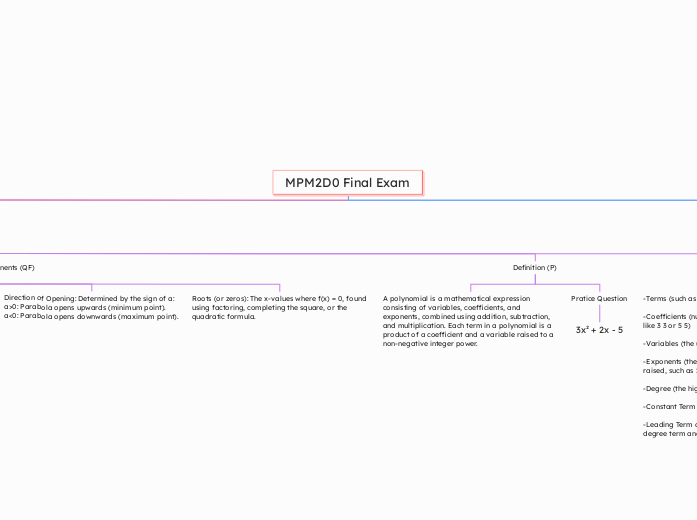MPM2D0 Final Exam
Linear Systems
Definition
A Linear Systemis composed of two or more linear relations. To solve a LinearSystemyou must determine which values of x and y are common to all lines. This occurs at the pointofintersection.
Key Components
Linear Equations
A linear equation has the general form: ax+by+c=0
Variables
A sign used to use for numbers.
Example: x,y,z
Coefficients
The multipliers of the variables in each equation.
They define the slope of each variable in the equation.
Example: a1, a2.
Elimination
Subtopic
Types of Solutions
-A unique solution: A single set of values for the variables satisfies all equations (e.g., the lines intersect at one point in a 2D system).
-No solution: The equations represent parallel lines that never intersect.
-Infinitely many solutions: The equations represent the same line or overlap completely (dependent system).
Quadratic Functions (QF) /Polynomials (P)
Forms (QF)
Standard: (y=ax²+bx+c)
Vertex: (y=a(x-h)²+k)
Factored: (y=a(x-r)(x-s))
Definition (QF)
The graph of a quadratic function is a parabola, which can open upwards (if a > 0) or downwards (if a < 0).
A quadratic function is defined as a polynomial where the highest degree of any variable is 2. In other words, a term in the equation will have an exponent to the power of 2.
Practice
2x² - 2x - 24 = 0
Key Components (QF)
Vertex: The highest or lowest point of the parabola.
Axis of symmetry: A vertical line passing through the vertex, dividing the parabola into two symmetric halves.
Direction of Opening: Determined by the sign of a:
a>0: Parabola opens upwards (minimum point).
a<0: Parabola opens downwards (maximum point).
Roots (or zeros): The x-values where f(x) = 0, found using factoring, completing the square, or the quadratic formula.
Definition (P)
A polynomial is a mathematical expression consisting of variables, coefficients, and exponents, combined using addition, subtraction, and multiplication. Each term in a polynomial is a product of a coefficient and a variable raised to a non-negative integer power.
Pratice Question
3x² + 2x - 5
Key Components (P)
-Terms (such as 3 𝑥 2 3x 2 , 5 𝑥 5x, and 2 2)
-Coefficients (numbers multiplying the variables, like 3 3 or 5 5)
-Variables (the unknowns, typically 𝑥 x or 𝑦 y)
-Exponents (the powers to which the variable is raised, such as 2 2 in 𝑥 2 x 2 )
-Degree (the highest exponent)
-Constant Term (the part without a variable)
-Leading Term and Leading Coefficient (highest degree term and its coefficient)
-The degree of a polynomial is the highest exponent of the variable in the polynomial.
-Example: In 3 𝑥 2 + 5 𝑥 + 2 3x 2 +5x+2, the degree is 2 2, since the highest exponent of 𝑥 x is 2.
-The degree gives you important information about the behavior and graph of the polynomial.
Analytic Geometry
Formulas
Key components
Coordinate System:
Axes: Two perpendicular lines, 𝑥 x-axis (horizontal) and 𝑦 y-axis (vertical).
Origin: Intersection of 𝑥 x- and 𝑦 y-axes, denoted as ( 0 , 0 ) (0,0).
Quadrants: The plane is divided into four quadrants.
Definition
The use of a coordinate system tot relate geometric points to real numbers. By defining each point with a unique set of real numbers, geometric figures such as lines, circle, and conics can be described with algebraic equations.
Trigonometry
Formulas
In any right triangle:
sin 2 ( 𝜃 ) + cos 2 ( 𝜃 ) = 1 sin 2 (θ)+cos 2 (θ)=1
Other forms include: 1 + tan 2 ( 𝜃 ) = sec 2 ( 𝜃 ) , 1 + cot 2 ( 𝜃 ) = csc 2 ( 𝜃 ) 1+tan 2 (θ)=sec 2 (θ),1+cot 2 (θ)=csc 2 (θ)
Right Triangles
Use basic trigonometric ratios to find unknown sides or angles.
Oblique Triangles Use the Law of Sines: 𝑎 sin ( 𝐴 ) = 𝑏 sin ( 𝐵 ) = 𝑐 sin ( 𝐶 ) sin(A) a = sin(B) b = sin(C) c Use the Law of Cosines: 𝑐 2 = 𝑎 2 + 𝑏 2 − 2 𝑎 𝑏 cos ( 𝐶 ) c 2 =a 2 +b 2 −2abcos(C)
Definiton
Trigonometry is the branch of mathematics that studies the relationships between the angles and sides of triangles, particularly right triangles, and extends to the analysis of periodic phenomena using trigonometric functions like sine, cosine, and tangent.
Key Components
The six primary trigonometric functions:
-Sine (sin)
-Cosine (cos)
-Tangent (tan)
-Cosecant (csc)
-Secant (sec)
-Cotangent (cot)
Triangles
Right Triangle: The primary focus of trigonometry.
Hypotenuse: The side opposite the right angle (longest side).
Adjacent Side: The side next to a given angle.
Opposite Side: The side opposite a given angle.
Subtopic
